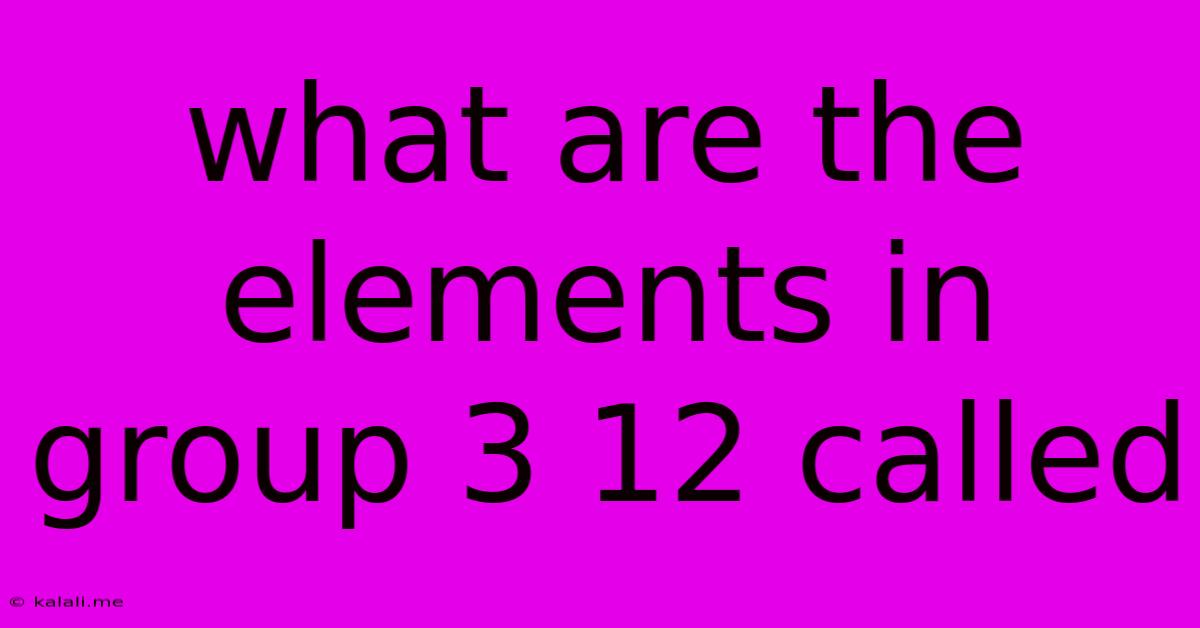What Are The Elements In Group 3 12 Called
Kalali
Jun 13, 2025 · 3 min read

Table of Contents
What Are the Elements in Groups 3-12 Called? Transition Metals: A Deep Dive
The elements in groups 3 through 12 of the periodic table are collectively known as transition metals. This isn't just a convenient label; it reflects their unique chemical and physical properties that set them apart from other elements. Understanding what makes these elements "transition" elements is key to appreciating their widespread use in various industries and technologies. This article will explore the characteristics and significance of transition metals.
What defines a transition metal?
The definition of a transition metal is based on their electronic configuration. Specifically, they are characterized by:
-
Partially filled d orbitals: Transition metals have incompletely filled d electron shells in at least one of their oxidation states. This incomplete d subshell is the primary reason for their distinctive properties. It's this characteristic that allows them to form multiple oxidation states, creating a variety of compounds with diverse properties.
-
Variable oxidation states: Unlike alkali metals or alkaline earth metals which typically have one or two oxidation states, transition metals often exhibit multiple oxidation states. For example, iron (Fe) can exist as Fe²⁺ and Fe³⁺, leading to distinct chemical behavior and the formation of different compounds.
-
Formation of colored compounds: Many transition metal compounds are brightly colored. This is due to the absorption of specific wavelengths of light by the d electrons, resulting in the transmission or reflection of other wavelengths, creating the observed color. The specific color varies depending on the metal and its oxidation state.
-
Catalytic activity: Many transition metals and their compounds act as excellent catalysts. This is because they can readily accept or donate electrons, facilitating chemical reactions without being consumed themselves. This catalytic property is crucial in many industrial processes, such as the Haber-Bosch process for ammonia synthesis.
-
Paramagnetism: The presence of unpaired electrons in the d orbitals often leads to paramagnetism – a weak attraction to a magnetic field. This property can be used to identify and characterize transition metals.
-
Formation of complex ions: Transition metals have a strong tendency to form complex ions – ions where the metal ion is surrounded by ligands (molecules or ions). These complexes often exhibit unique properties, such as specific colors and reactivity.
Specific examples of transition metals and their uses:
The transition metals are incredibly diverse, each with its own set of properties and applications. Here are a few notable examples:
-
Iron (Fe): Essential for steel production, vital for construction and various industries. Also crucial in biological systems, forming part of hemoglobin.
-
Copper (Cu): Used extensively in electrical wiring due to its excellent conductivity. Also used in plumbing and various alloys.
-
Titanium (Ti): Known for its high strength-to-weight ratio, making it ideal for aerospace applications and medical implants.
-
Platinum (Pt): A valuable catalyst in many chemical reactions, including automotive catalytic converters. Also used in jewelry.
-
Chromium (Cr): Used in stainless steel to enhance corrosion resistance. Also used in chrome plating for decorative purposes.
-
Nickel (Ni): Used in various alloys, such as stainless steel and nickel-cadmium batteries.
Conclusion:
The elements in groups 3-12 of the periodic table are aptly named transition metals. Their partially filled d orbitals give rise to a unique set of characteristics, including variable oxidation states, color formation, catalytic activity, and the ability to form complex ions. These properties make them essential components in numerous technologies and industrial processes, highlighting their significant contribution to modern society. The study of transition metals continues to be an active area of research, with ongoing discoveries expanding our understanding of their diverse functionalities.
Latest Posts
Latest Posts
-
Is Density The Same As Mass
Jun 14, 2025
-
Which Trophic Level Has The Most Energy
Jun 14, 2025
-
How Many Milliliters Are In 1 Kiloliter
Jun 14, 2025
-
Shark Is To Fish As Dolphin Is To
Jun 14, 2025
-
The Relationship Between Celsius And Fahrenheit Is That
Jun 14, 2025
Related Post
Thank you for visiting our website which covers about What Are The Elements In Group 3 12 Called . We hope the information provided has been useful to you. Feel free to contact us if you have any questions or need further assistance. See you next time and don't miss to bookmark.